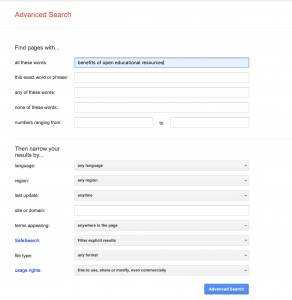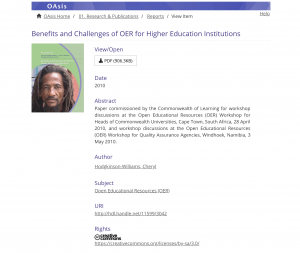Online educational resources (OER) are free educational materials that can be used for teaching, learning, research, and other purposes (Open educational resources., 2020). One can personalize their overall learning experience according to their own pace (raccoongang, n.d). OER allows individuals to have quick access to all the latest information (raccoongang, n.d). OER includes course material, textbooks, streaming videos, and examines (Open educational resources., 2020). They can be adapted and re-purposed by others (Who Puts the Education into Open Educational Content?, n.d.) accordingly. Openly licensed educational content acknowledges the content is openly available, meaning it is readily available to be found or discovered. Licensing allows for content to be openly accessible and openly reusable in a way that the user can modify it according to what they require from the information presented. In other words, online open educational content is anything one can find online, while the open-licensed means that one is allowed to freely use that content with the given permission.
The steps I took to find my chosen OER, first began by starting with the google advanced search. From there I ensured that I was using “free to use, share or modify, even commercially’. Once I found an OER I wanted to use, I was able to evaluate my findings. My OER finding was information that was relevant to this course as it discusses many of the information for this week’s topic. The accuracy seems legit has it has been peer-reviewed and is a scholarly article. The production quality is clear, understandable, easy to navigate, as well as design features. Accessibility is also available for this content. I was able to download a PDF of the article. The licensing for the article is creative commons.
The task was more tedious than usual when finding resources. When ensuring there were licensed that allowed me to use the information, I needed to double-check the resource followed the OER guidelines. This was a step I had never considered when looking for information when thus it added a couple of extra steps. I needed to ensure my sourced followed the provided guidelines which were quite time-consuming. Nerveless, I do understand from an educational purpose, OER does have a beneficial aspect to it. For starters, OER allows for an instructor to use material from other sources without getting granted permission and this does save overall time for the individual who will be using the information they discovered (Module 10: Why OER Matters., n.d.). OER also provides cost-saving for students. Saving cost on things like textbooks and other course materials (Module 10: Why OER Matters., n.d.). OER also grants access to more quality resources (Module 10: Why OER Matters., n.d.). OER allows for greater learning opportunities. The material from one resource to another will be shared across more individuals (Module 10: Why OER Matters., n.d.). OER provides peace of mind for all users. One does not need to stress when re-using material with OER (Module 10: Why OER Matters., n.d.). The resources are licensed to allow the sharing of content (Module 10: Why OER Matters., n.d.). To conclude, I would use OER for future research I conduct because I would feel secure in the information I am using as I know there are licenses in place that allow me to do so.


Link: OER
Article: OER
Citation
Cheryl. (1970, January 1). Benefits and Challenges of OER for Higher Education Institutions. Retrieved from http://oasis.col.org/handle/11599/3042
Module 10: Why OER Matters. (n.d.). Retrieved from https://www.openwa.org/module-10/
Open educational resources. (2020, January 30). Retrieved from https://en.wikipedia.org/wiki/Open_educational_resources
Who Puts the Education into Open Educational Content? (n.d.). Retrieved from https://www.educause.edu/research-and-publications/books/tower-and-cloud/who-puts-education-open-educational-content
(n.d.). Retrieved from https://raccoongang.com/blog/quick-list-open-educational-resources-examples/